The ninja sword - fact or myth...?
Pavel Bolf
A ninja, a shadow warrior dressed all in black and armed with a typically straight sword - the ninja-tó - in addition to a host of hidden weapons. There are few ninjutsu-themed popular literature or films where ninjas are not depicted with this weapon. However, in a deeper study of Japanese swords, the term ninja-tó is virtually unheard of. So what is the reality? Is there a sword in Japanese history that matches the description of the one referred to as a ninja-tó?
Ninja-tó is described as a sword with a shorter straight blade. The koshirae (set) includes a large tsuba-shaped sword guard. This was intended as an aid in scaling walls and ramparts. In the cavities of the saya sword sheath were hidden other concealed weapons, poisons and other aids that a ninja could not do without. The sword set was austere and unadorned, usually black in color.
The straight blade, the large square guard, the various cavities for concealing objects, and the lack of decoration are thus essential features that should distinguish a sword used by a ninja from one used by a samurai.
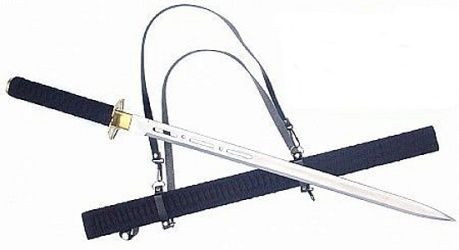
When studying Japanese swords, it is possible to come across several straight-bladed longswords. These are the ken, whose blade has a cutting edge on both sides. This sword is often depicted in stylized form on engravings of horimono swords. It is associated with Japanese mythology and religion. However, due to its shape and double-edged blade, it does not fit the description of a ninja-tó.

Ken

Horimono stylized ken with dragon

Horimono stylized ken with dragon
Much more similar in shape are the chokuto swords used before the advent of blades with a classic curve. These are swords with a single-edged blade, a beveled tip and hardened to hamon.
In some cases, blades of this type have grooves or simple engravings.
However, the set of these swords was usually in the tachi style, i.e. worn on hinges with the blade down. This type of sword was part of the equipment of the ancient Japanese nobility and had nothing to do with ninjas.

Chokuto

Tachi koshirae
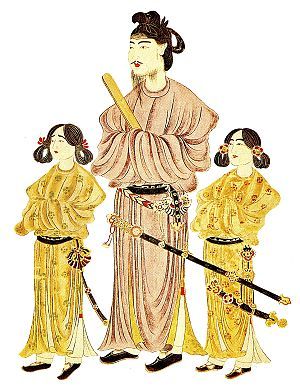
Depiction of a nobleman of the Nara / Heian period
Due to the disadvantages of straight blades, the era of blades with a pronounced curvature began around the 9th century. These were less prone to breakage and also had a significantly better ability to cut in proportion to the force applied than a straight blade. Very simplistically, one could say that swords of the Koto period (ca. before 1600) had more curved blades and swords of the Shinto period (after 1600) had blades with less pronounced sori curvature. However, this statement is not very objective; in both cases it is possible to find a number of exceptions. The shape and curvature of the blade was subject to the manner of warfare, the needs of the individual, and fashion. Fashion influences had the opportunity to be most pronounced in the peacetime periods of the Edo period and subsequent eras up to the Meiji reforms (1868-1912), when the samurai state was officially abolished.
The greatest reformation occurred again with sword blades in the Kanbun (Shinto) period. Swords of this period had minimal deflection, often only a few millimetres.

Katana kabun, sori 3 mm

Koshirae kabun
One theory of the origin of such straight blades is that samurai practiced swordsmanship techniques (kenjutsu) with straight wooden sticks (bokken). The swords were shaped to fit these sticks. Another theory states that the stabbing technique (tsuki) became more widely used, and for this, the use of a straight-bladed sword is preferable. However, these are theories. However, the fashion for straight blades soon faded away and later swords produced again have sori of around 15mm or more.
Another distinguishing feature of the ninja-tó is the large square-shaped tsuba. Tsubas are classified in Japanese terminology according to shape and type. A square tsuba is referred to as a kakugata. However, there are a number of tsubas that are close to square in shape. Significantly, however, this shape of guard was commonly used on the sets worn by samurai. Significantly larger tsub sizes exceeding 9 cm in diameter are also not uncommon. The use of the guard as a footstool when climbing walls was not the prerogative of ninjas. This technique was also popularly used by the ronin kabukimono (masterless samurai) when breaking into the houses of wealthy townspeople. This mischief-making was so widespread that it even led to the Edi Magistrate issuing a ban on the wearing of square tsubas on swords in 1645.
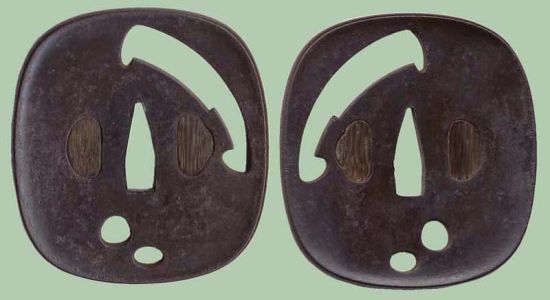
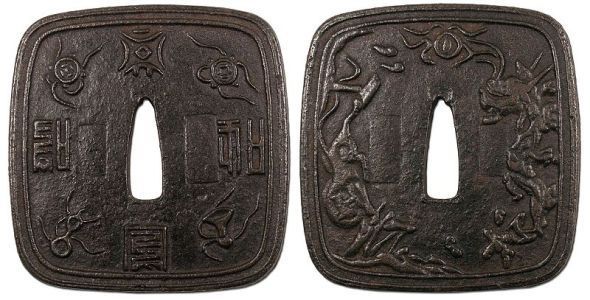
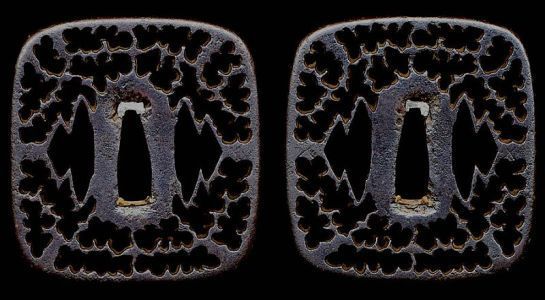
Examples of square-shaped tsuba
The boxes in the scabbard of the sword saya are also not an unsubstantiated fable. They were cavities in the walls of the saya. Even in samurai swords, the common equipment of the sword included boxes for the kogatana knife and the kogai needle. Hidden in hidden compartments were, for example, gold coins. Of course, anything that could fit in the box could be hidden here.
It would be surprising if ninja didn't use similar boxes in saya. It is also possible that the box system was used more extensively in ninja swords.
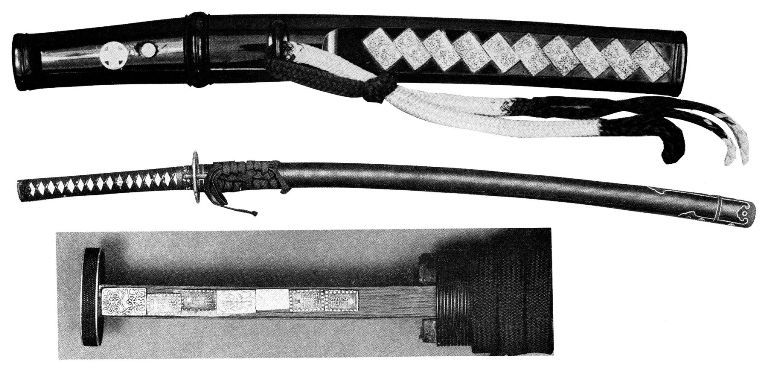
Coin stashes
The severity of the sword's equipment was also not the prerogative of ninjas, nor was its black color. The decoration of sword parts did not gain its greatest momentum until the peacetime Edo period. The swords of wealthy samurai and merchants thus became a showcase for their wealth and the craftsmanship of their makers. However, in times of war there were very austere sets of samurai swords, lacking any decoration. Black lacquer was the most common colour used on sword sets. The hilt braid was also heavily varnished on the combat sets. The white colour of the same (stingray skin covered the hilt under the braid) was rather rare on uchigatana sets before the Edo period. Even the same used to be covered with a thick layer of urushi lacquer. Everything was subordinated to expediency and weather resistance. The sword in the field of war was exposed to snow, rain, mud and sun, as well as mechanical stress. There was certainly no shortage of abrasion. The rich decoration of a sword subjected to such stress would have suffered greatly and its use was not appropriate.

Strict combat koshirae

Decorated koshirae
The existence of swords with straight blades, square or square-shaped swords, the use of sheaths for blades and their hidden forms, the austerity of sword sets and their black colouring are all documentable facts from the history of the Japanese sword. Likewise, the use of the sword for purposes other than chopping and stabbing is not uncommon, and some of these techniques are still taught in older styles of Japanese swordsmanship today. The art of ninjutsu is probably fundamentally superior to these styles in this respect.
However, the existence of ninjutsu as depicted in many films is hard to substantiate. It is therefore more of a myth created by the American film industry. From there, it spread on and became part of the ninja tradition presented to the general public. It is likely that throughout history at least one ninja warrior used a sword similar to the one we know from the movies. However, if a samurai had acquired a sword in the Kanbun period with a nearly straight blade, fitted it with a large square cuboid and an undecorated black set with kogatan, kogai and money pouches, he would hardly have been considered a ninja and his sword referred to as a ninja-tó. And that's probably not even if he was in a black outfit climbing over the wall of a house using his sword. He'd just be a samurai doing mischief with a straight katana sword, furthering the myth of the ninja-tó.
Translated with www.DeepL.com